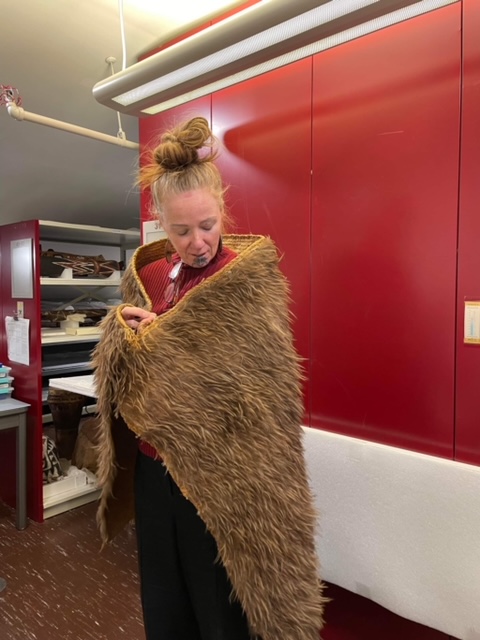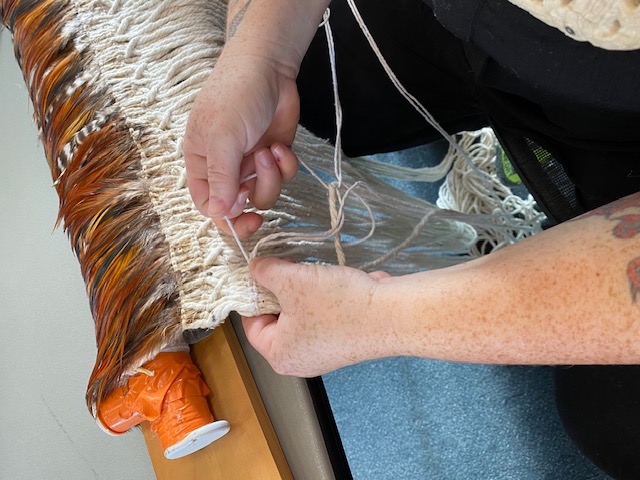“Korowai” has been used as the generic term for a traditional Māori cloak. But there are many variations.
There are traditional and contemporary cloaks. Some even use kiwi feathers and some use dog skin.
Whatu kākahu is the correct name for traditional Māori cloaks.
Re: News spoke to kaiwhatu (weaver) Dr Hinekura Smith (Te Rarawa, Ngāpuhi) about whatu kākahu, how long they take to make and how much you can expect to pay for one.

Dr Hinekura Smith. Photo: supplied.
What are whatu kākahu?
Whatu (finger weaving) is the practice and a whatu kākahu is a cloak that has been made through the practice of whatu.
Kākahu also means clothes so whatu kākahu is a subset of that which are cloaks made through the process of whatu.
A kahu kiwi is a cloak made using kiwi feathers, and a kahu kuri is a cloak made using kuri skin.
In more recent times, we've wanted to develop language around this more contemporary modern kākahu.
I guess they are not whatu kākahu because they are not made using finger weaving practices, they may be sewn. I recognise that there is still a story and there’s still aroha and intent.
If a mokopuna is graduating and the nannies get out an old blanket and sew it up, that’s still beautiful. It’s still a kākahu.

Dr Hinekura Smith weaving a whatu kākahu. Photo: supplied.
What about people who call all whatu kākahu 'korowai'. Can you explain why 'whatu kākahu' is the correct terminology?
The simple answer is that korowai is one particular type of cloak, yet the word korowai has been taken up and generalised across all types of cloaks.
We want people to understand that there are many different types of whatu kākahu, and korowai is just one.
Korowai generally have no feathers on them, it will have hukahuka (tassels).
How long do they take to make?
They can take anywhere between a year or two.
How much can someone expect to pay for one?
They're several thousands of dollars.
When it comes to whatu kākahu made with muka (prepared flax fibre), natural fibres and native bird feathers you're looking at at least $10,000.
Let's say I make a kākahu using contemporary materials, like mop string and cotton. It could still take me 200 hours. If I were to charge myself a minimum wage of $24 an hour, all that is paying for is the time, not even the cost of the materials.
What are they used for?
Kākahu Māori are a beautiful visual expression of Māori identity and have become commonplace at graduation ceremonies, weddings and birthdays used to celebrate special occasions.
However, they were and should once again be made visible across broader contexts.
For example encouraging our tamariki to wear a kākahu when they stand to kōrero or karakia, wearing kākahu at pōwhiri ahakoa te kaupapa (no matter the kaupapa).
It concerns me to see kākahu described as ‘wedding’ or ‘graduation’ cloaks when they are more than symbolic of the occasion and instead expressions of pride in our Māori identity and whakapapa.
When it comes to tangihanga (funerals), our practice is that when the ties of the kākahu are by the feet of the tūpāpaku (deceased person’s body) then you can lay it on them and take it off afterwards.
When the ties are at the top near their chest, it's generally a sign that the kākahu is going to be returned back to the earth.
It’s a huge sign of respect to the tūpāpaku (deceased person’s body) when the kākahu is laid to be buried. It’s very beautiful.
How do you find the right kaiwhatu (weaver)?
I think the most powerful thing about having whatu kākahu come into your whānau is the relationship and connection.
Something to consider is that whatu kākahu which is made from muka (prepared flax fibre) actually carries DNA from the kaiwhatu.
The DNA is literally weaved into that whatu kākahu.
The whatu kākahu that I make using muka (prepared flax fibre) will one day be passed down to my great-great-grandchildren who will have my DNA on their skin. Isn't that just so beautiful?
What is inappropriate to do when wearing kākahu?
What makes it inappropriate, is anything that would diminish the mana of that kākahu or the kaiwhatu.
Drinking, smoking, going to the toilet or even swearing can all be seen as inappropriate.
You also wouldn’t wear it out in the rain like a raincoat.
When you consider how much time goes into making kākahu, you’ll treat and wear that kākahu a particular way.
When I think about kapa haka, and the kids that sit there for months making their own kākahu, they look after them so much better when they’ve made them themselves.
Can anyone buy and own one?
In similar ways, I think that tā moko (traditional tattoo) and wearing greenstone can get taken up as [part of] being a “Kiwi”.
I’ve never called myself a “Kiwi”.
I think there is a risk of kākahu being mistaken as a “Kiwi” thing. It is very Māori, it’s a Māori practice.
Just like any of our taonga, I would question whether it's appropriate for just anyone to have one.
More stories:
Should tikanga Māori be taught in law schools?
"It's important law reflects the society it governs."
A person with borderline personality disorder answers your questions
“People say ‘They're crazy, they can't have relationships’. That hurts me.”
How NZers are protesting Israel with their wallets
Boycotting has become a major tool for New Zealanders looking to support the Palestinian